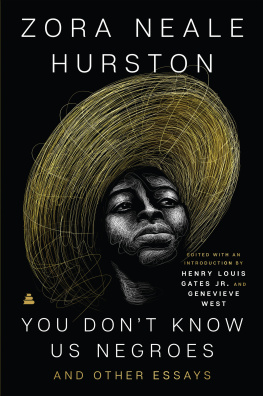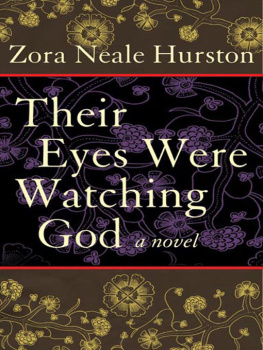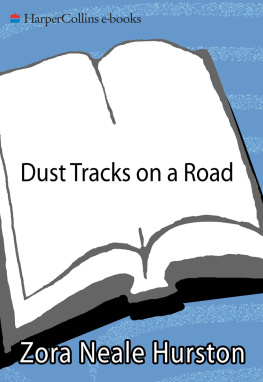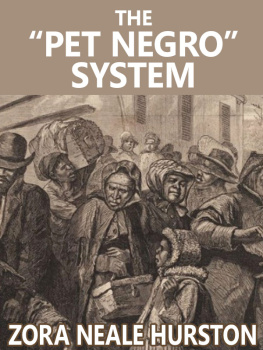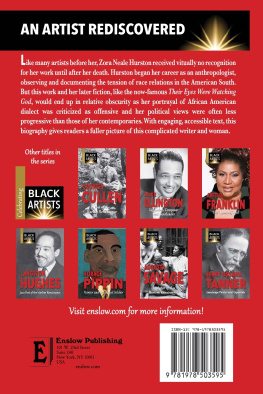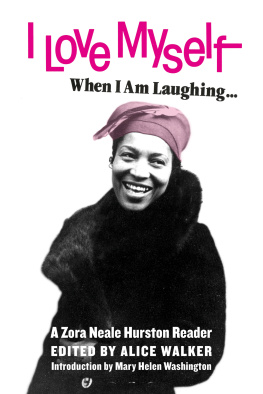Contents
Guide
Contents
Im going to sit right here on this porch chair and prophesy that these are the last days of the know-nothing writers on Negro subjects. Both editors and readers are clamoring for something that makes their side meat taste like ham, for to tell the truth, Negro reality is a hundred times more imaginative and entertaining than anything that has ever been hatched up over a typewriter. From now on, the writers must back their rubbish with something more substantial than the lay-figure of the past decade. Go hard or go home. Instead of coloring up coconut grease in the kitchen, go buy a cow and treat the public to some butter.
Zora Neale Hurston, from You Dont Know Us Negroes
The witty rhyme with which Zora Neale Hurston ends the title essay of this collectionBiddy, biddy, bend, my story is end,/ Turn loose the rooster and hold the hencan be taken as a sort of epitaph for her, certainly, but also as the naming of a key theme to which she returns again and again throughout the essays she wrote over almost four decadesmonumental decades that saw the birth of the Harlem Renaissance and the launch of the classic period of the civil rights movement with the Montgomery Bus Boycott; the desegregation of the US military and the integration of Central High School in Little Rock, Arkansas. Through these essays, collected in one volume for the first time, Hurston takes her place as a major essayist of the twentieth century.
Hurstons words in the epigraph above would prove prophetic. The renowned Black psychiatrist from Martinique, Frantz Fanon, brilliantly observed that the West could never understand the being of the black man, since it ignores [Black peoples] lived experience. And so, she argues, the writings that made out they were holding a looking-glass to the Negro had everything in them except Negroness. Some of the authors meant well. The favor was in them. They had a willing mind, but too light behind. Slavery, Jim Crow, white supremacy, and anti-Black racism, she explains, intensified our inner life instead of destroying it. And rather than using literature to deflect the white gaze, Hurston maintained that the purpose of the Black writer was both to lift the Veil and to allow the Black experience to speak in its own voice, in all of its sublime resonancegood and bad, positive and negative.
Reading Hurstons reflections on the inner logic of Black cultural forms, social institutions, and behavior is a bit like overhearing an internal monologue in the same way that soliloquies function in Shakespeare. This is one of the innovations she makes in the history of the African American essay form. And throughout these essays, she argues that the full richness of the African American experience could only be realized in print if writers allowed the tradition to speak for itself, thus revealing a genuine bit of Negroness in the same way blues and jazz artists had done in the secular tradition; Black preachers and the unknown bards had done in their compositions of sermons, spirituals, and gospel music; and as she herself had done, much to the annoyance of Black male contemporaries such as Richard Wright and Alain Locke, in Their Eyes Were Watching God (1937). Her lesser-known essays Race Cannot Become Great Until It Recognizes Its Talent, You Dont Know Us Negroes, and The Chick with One Hen capture these lifelong aesthetic commitments to lift the Veil.
One of the delightful aspects of Hurstons nonfiction is the subtle way in which it serves as commentary on her practice of fiction writing in a relationship of theory to practice. Her foundational essay Characteristics of Negro Expression, for example, is an attempt to define systematically, like a linguist would, the unique ways in which African Americans speak, the ways in which the American Negro has done wonders to the English language. This essay is one of the first attempts to arrive at a typology of Black English, helping us to understand the principles behind her representation of Black speech in her novels. Hurston identifies the Negros greatest contribution to the language as these three original usages: metaphor and simile (You sho is propaganda); the double-descriptive (chop-axe); and verbal nouns (I wouldnt scorn my name all up on you). These she groups under the larger Black aesthetic principle of the will to adorn. Then she traces examples of this originality in traditional Black artistic forms, such as folklore, prayers, and sermons. These religious forms, she says, are tooled and polished until they are true works of art, forged in the frenzy of creation, a theme to which she returns several times in these essays. The beauty of the Old Testament does not exceed that of a Negro prayer, she asserts. As rendered in print, dialect, which Hurston distinguishes from idiom, was the often racist representation of Black spoken English, widely dismissed as a sign of Black peoples lack of intelligence, in minstrelsy, dialect poetry, and vaudeville. But when flowing from Hurstons pen to page, her use of idiom underscores the beauty and range of what is actually a poetic diction, a language within a language. She highlights the manner in which African Americans have fashioned, and continue to refashion, the English language in their own resplendent voices, investing in English new power, poetry, neologisms (colorful coinings of words and expressions), and originality of expression, a thing at which to marvel and not to mock.
For Hurston, Black Vernacular English and folk cultural forms are two of the African American peoples most original contributions to American culture. Most importantly, she argues, the cultural artifacts produced by the enslaved community and their heirs are proof that the will to adorn, in spoken English and storytelling, in the composition of sacred forms such as sermons, prayers, and the spirituals, in the blues and jazz, was one of the most salient signs of cultural vitality and survival and adaptation in the face of the horrors of enslavement and Jim Crow. These forms are parts or manifestations of what we might think of as a larger, organic culture of themselves, one that Black people formulated behind the Veil. And in these essays, Hurston is determined, detail by detail, to lift that Veil for the world to see, and just as importantly, to hear the sounds of African American cultural formations. She mounts a defense of what we might think of as traditional Black culture against those who would disparage it, be they white or members of the Black middle class.
Hurston can be quite bold in her taxonomies of what she terms Negro Folklore. For instance, she characterizes Jack or John and Brer Rabbit, Black cultures ultimate heroes, both with the wit and power to defeat the Master and, in Johns case, even the Devil, as he is often smarter than God. She also, in several asides, characterizes the Black Church as something of its own, a sui generis belief system: in the essays Culture Heroes section, she daringly writes, The Negro is not a Christian really, because of the vestiges of African religions still very much alive and patently manifest in traditional forms of worship, especially in the South. We are not Christians really, but pagans, she repeats in Full of Mud, Sweat and Blood, her review of David Cohns novel God Shakes Creation. It is true that we employ all of the outward symbols of Christianity, but it is a beating of drums before new altars and calling old gods by new names.
The church, to Hurstons mind, is also the ultimate source of the most sublime Black poetry:
The finest poetry that has come out of the Negro race so far has come out of the church, out of the mouths of preachers. If a man announces that he is called to preach and cannot get up in the pulpit and call God by all His praise-giving names; cannot gild the sunrise; heighten the glory of the rainbow, he will soon find himself back at his plowing and digging. Like others we have that consciousness of the inexpressible and a hunger for beauty, and the preacher must fill that want.

